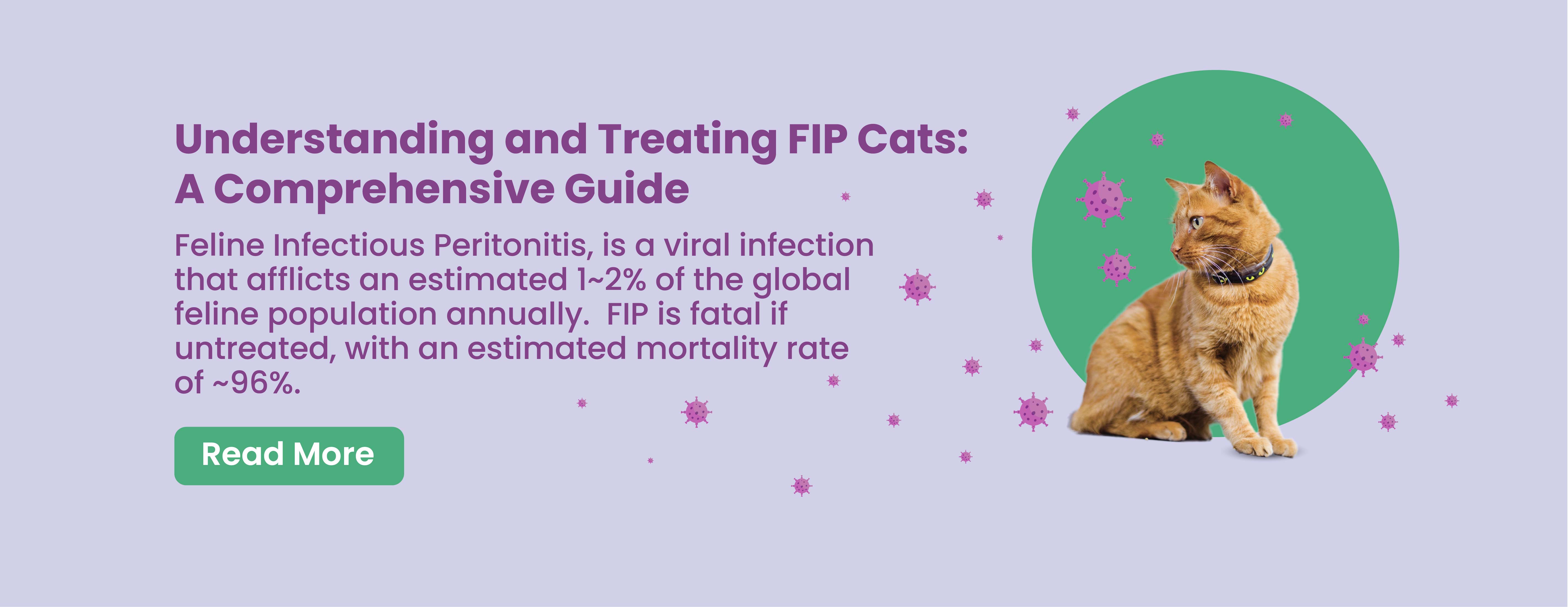 FIP Cats Treatment Guidelines: Effective Solutions for FIP in Cats
FIP Cats Treatment Guidelines: Effective Solutions for FIP in Cats
FIP (Feline Infectious Peritonitis) is a severe disease that affects cats, caused by the mutation of the feline coronavirus. Early detection and treatment, especially with antiviral drugs like GS-441524, can significantly improve survival rates. Recognizing common FIP in cats symptoms such as fever, weight loss, vomiting, and fluid accumulation in the abdomen (wet FIP), or organ damage (dry FIP), is crucial for early intervention. Below, we explore the latest treatments and prevention strategies for cats with FIP symptoms.
What is FIP Cats?
Feline Infectious Peritonitis (FIP) is caused by the mutation of the Feline Coronavirus (FCoV). This virus is often spread through the saliva, feces, and urine of infected cats, but FCoV itself is not fatal. However, when FCoV mutates into FIP, it becomes deadly. This disease mainly affects young cats and is a common cause of mortality.
The symptoms of FIP cats vary depending on the form of FIP the cat is experiencing. There are two forms of FIP:
Wet FIP
Dry FIP
If not treated early, both forms of FIP can progress into:
Neurological FIP
Ocular FIP
Recognizing Symptoms of FIP Cats
FIP in cats symptoms can vary depending on the type of FIP. Wet FIP is the more common form and is characterized by fluid accumulation in the abdomen or chest. Symptoms of this form of FIP include weight loss, loss of appetite, vomiting, diarrhea, and difficulty breathing.
Some common symptoms of FIP in cats include:
Cat Fever
Cat Lethargy
Cat Loss of appetite
Drastic weight loss
Cat Vomiting
Cat Diarrhea
Difficulty in breathing
Fluid buildup in the abdomen (Wet FIP)
Cat Jaundice
Cat Anemia
In certain conditions, late FIP treatment can lead to other symptoms, such as neurological symptoms (neurological FIP) or eye problems (ocular FIP).
Diagnosing FIP Cats
Diagnosing FIP in cats can be difficult, as the symptoms can be similar to those of other diseases. To confirm a diagnosis of FIP in your cat, several tests should be performed. These tests include:
FCOV AB Test: This test looks for antibodies to the virus that causes FIP.
Rivalta Test: This test is performed if there is fluid accumulation in the abdominal cavity.
Hematology and Chemistry Blood Tests: These tests help to confirm levels of albumin, globulin, liver and kidney values.
Ultrasound (USG): This test is used to confirm fluid in the abdominal cavity.
FIP Cats Treatments
FIP Cats disease was once considered a death sentence for cats, however, hope has emerged for cats with FIP. With the availability of GS-441524 treatment, the prognosis for cats with FIP has greatly improved.
GS-441524 is an antiviral drug developed by Dr. Niels Pedersen in research to cure FIP in cats. It has gone through clinical trials and proven to be very effective in curing cats affected by FIP, with an efficacy rate up to 87%.This FIP Cats treatment has been proven effective, leading many to ask "can a cat survive FIP?" The answer is increasingly yes, and if you suspect that your cat has FIP, it is important to consult with a veterinarian as soon as possible to ensure prompt and effective treatment.
Preventing FIP in Cats
The best way to prevent FIP in cats is to keep them in a clean and healthy environment. This means keeping their litter boxes clean and making sure they have access to fresh, clean water. It is also important to keep cats up to date on their vaccinations, as this can help reduce the risk of FIP.
It is also important to keep cats away from other cats that may be infected with FIP. If your cat does come into contact with an infected cat, it is important to keep a close eye on them for any signs of illness.
Diet and Nutrition for FIP Cat Disease
Diet and nutrition play an important role in managing the symptoms of FIP cats. It is important to feed your cat a well-balanced diet that is high in protein and low in carbohydrates. Fresh, raw food is best, as this provides the most nutrients for your cat.
It is also important to feed your cat food that is specifically designed for cats with FIP. These diets are formulated to provide the nutrients that cats with FIP need to stay healthy.
It is also important to make sure that your cat is getting enough water. Cats with FIP tend to become dehydrated easily, so it is important to provide them with plenty of fresh, clean water.
Tips for Caring for a Cat with FIP
Caring for a cat with FIP can be a challenging task. It is important to be patient and understanding, as cats with FIP can be easily stressed or overwhelmed.
It is important to provide your cat with a safe and comfortable environment. Make sure to keep the litter box clean and provide plenty of fresh, clean water. It is also important to keep the cat away from other cats, as FIP is highly contagious.
It is also important to keep your cat up to date on all of their vaccinations, as this can reduce the risk of FIP.
Finally, it is important to provide your cat with plenty of love and affection. Cats with FIP need a lot of special care and attention, and providing them with love and affection can help them feel better and cope with the disease.
Sekiranya kucing anda menunjukkan gejala FIP, bawa mereka ke doktor haiwan terdekat anda untuk diagnosis dan rawatan yang betul. Jika anda mempunyai sebarang soalan atau kebimbangan mengenai FIP dan rawatannya, jangan teragak-agak untuk menghubungi kami di WhatsApp Basmi FIP atau lawati Instagram kami untuk mendapatkan maklumat lanjut.
FIP Cat Disease FAQ
What should I feed my cat during the treatment?
Freshly cooked fish, chicken and other natural foods. If your cat has diarrhoea, consider switching to dry cat food for a few days until diarrhoea stops.
How long is the treatment?
The recommended length of treatment is 12 weeks. However, the actual treatment length may depend on many factors such as how quickly your cat responds to the treatment, the stage of the FIP infection when you began the treatment, and your personal financial situation.
Can GS-441524 be used along with other medications?
Yes, GS is an antiviral treatment, and can be used with other medications to improve the overall health of your cat. However, Lysine is NOT recommended to use along with GS.
Can FIP be transmitted to other cats?
One of the concerns that often arises is whether cats infected with FIP will transmit the disease to other cats, especially in a multicat household. The answer is NO, a cat with FIP will not transmit the FIP virus to other cats. It also won't spread to other pets species and humans.
How is FIP Disease Transmitted in Cats?
However, keep in mind that the infectious virus is the source of FIP virus in cats, which is the Feline Coronavirus (FCOV) or also known as Corona in Cats. FCOV is a feline coronavirus that occurs in cats and is only transmitted between cats, and not to humans or other pet species. FCOV is usually asymptomatic and may cause diarrhea. Nearly 80% of the global cat population is infected with this virus. However, it is important to note that FCOV itself is not deadly, but it has the risk of mutating into FIP which is fatal to cats if left untreated.
Is FIP Transmitted from Cats to Humans?
NO, a cat with FIP will not transmit the FIP virus to other cats. It also won't spread to dogs and humans.
What is Dry FIP In Cats?
Dry FIP is another type of FIP disease. Dry FIP, unlike wet FIP, progresses without fluid accumulation in the cat's body. Instead, hard, nodal structures called granulomas form on the cat's body. These granulomas can cause damage to the cat's organs and tissues. The course of dry FIP is usually slower and its symptoms less severe. However, dry FIP can also cause serious health problems and reduce the cat's quality of life. The cause of dry FIP, like wet FIP, is related to the cat's immune system.
What is Wet FIP In Cats?
FIP is a feline disease called Feline Infectious Peritonitis. Wet FIP is the most common and dangerous type of this disease, often occurring in kittens between the age of 6 months to 1.5 years old. Wet FIP results in fluid accumulation in the cat's abdominal and thoracic cavity. This liquid is usually yellowish and sticky, causing discomfort by lowering the cat's body temperature.
What are the final stages of FIP in cats?
FIP Cats has 3 stages. The final stage is characterized by symptoms such as: Worsening of mid-stage symptoms, Stopping eating, cloudy eyes, loss of coordination or paralysis.
Can FIP Cats cure?
Yes, there is an effective treatment for FIP in cats using the antiviral drug called GS-441524. GS-441524 is an antiviral drug developed by Dr. Niels Pedersen in research to cure FIP in cats. It has gone through clinical trials and proven to be very effective in curing cats affected by FIP, with an efficacy rate up to 87%.
Contact Us for FIP Treatment Options
If your cat shows signs of FIP or you're concerned about potential symptoms, don't hesitate to contact us. We're here to provide the latest information and support for FIP cats treatment and care.
You can also reach out to BasmiFIP via WhatsApp or Instagram for guidance on handling FIP in cats. Being aware of changes in your cat’s behavior helps you detect health issues early and seek timely treatment.




